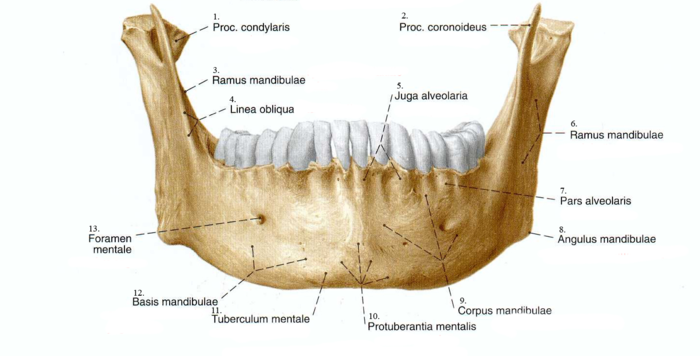Lower jaw

1. Frontal bone (Os frontale)
2. Parietal bone (Os parietale)
3. Nasal bone (Os nasale)
4. Ethmoid bone (Os ethmoidale)
5. Lacrimal bone (Os lacrimale)
6. Sphenoid bone (Os sphenoidale)
7. Occipital bone (Os occipitale)
8. Temporal bone (Os temporale)
9. Zygomatic bone (Os zygomaticum)
10. Upper jaw (maxilla)
11. Lower jaw (mandibula) (light blue)
12. Lower jaw angle (Angulus mandibulae)
The lower jaw or jaw ( lat. Mandible from mandere "chew") is a bone of the facial skull . In mammals, it is the mobile of the two jaw bones .

construction
The mandible consists of the horseshoe-shaped lower jaw body ( corpus mandibulae ), the front end of which supports the chin , and an ascending branch of the lower jaw ( ramus mandibulae ) on both sides . On the latter there is a muscle extension ( coronoid process ) to the insertion of the temporalis muscle and the articular process ( condylar process ) with the mandibular head ( caput mandibulae ), which forms the temporomandibular joint . The notch between the muscle process (formerly called the processus muscularis according to the old anatomical nomenclature ) and the articular process (formerly called the processus articularis according to old anatomical nomenclature ) is called the Incisura mandibulae .
The four masticatory muscles that ensure the jaw closure ( occlusion ) attach to the lower jaw . On the inside of the lower jaw, in the area of the premolars and molars, the mylohyoid crest , the insertion of the mylohyoid muscle, runs .
A bone tongue ( lingula mandibulae ) sits on the inside of the branch of the lower jaw and covers the foramen mandibulae (lower jaw hole). This hole is the entry point of the inferior alveolar nerve (from mandibular nerve of the trigeminal nerve ) and the artery and vein inferior alveolar nerve . The nerve runs in the mandibular canal (mandibular canal) under the tips of the roots of the posterior teeth and innervates the tooth sockets and teeth in the lower jaw. The terminal branch leaves the lower jaw body as the mental nerve at the mental foramen (chin hole) in the area of the root tips of the premolars . The lower jaw is supplied with blood via the inferior alveolar artery .
Linea obliqua mandibulae
The linea obliqua mandibulae is a ridge running diagonally over the bone, which runs cranially and dorsally to the anterior border of the respective ramus mandibulae. The triangularis muscle and the depressor labii inferioris muscle have their origin here, and the platysma is attached caudally . The insertion of the buccinator muscle is cranial to the oblique line on the alveolar process , directly below the molars .
- Lower jaw of man
Lower jaw movements
A distinction is made between the following movements of the lower jaw:
- Protrusion : movement of the lower jaw in an anterior direction
- Retrusion : movement of the lower jaw in the dorsal direction
- Laterotrusion : Movement of one side of the lower jaw away from the median plane
- Mediotrusion : Movement of one side of the lower jaw towards the median plane.
See also
- Bonwill triangle
- Mandibular fracture
- Upper jaw (maxilla)
- mandible
- Ark (horse) , the toothless part of the lower jaw in horses
literature
- Franz-Viktor Salomon: Bony skeleton . In: Franz-Viktor Salomon et al. (Hrsg.): Anatomie für die Tiermedizin . 3. Edition. Enke, Stuttgart 2015, ISBN 978-3-8304-1288-5 , pp. 103 .
- Klaus D. Mörike et al .: Textbook of macroscopic anatomy for dentists , Gustav Fischer Verlag, Stuttgart
- Terminology list of the German Society for Functional Diagnostics and Therapy (DGFDT) and the German Society for Dental Prosthetics and Materials Science (DGzPW); https://www.dgfdt.de/documents/266840/266917/06_Stellungnahme_Terminologie/5313e095-ced4-4ca0-b56d-7e6c504178e4?version=1.0
Web links
Individual evidence
- ↑ Federative Committee on Anatomical Terminology (FCAT) (1998). Terminologia Anatomica . Stuttgart: Thieme
- ↑ Lewis, CT & Short, C. (1879): A Latin dictionary founded on Andrews' edition of Freund's Latin dictionary. Oxford: Clarendon Press.
- ^ Joseph Maria Stowasser : Der Kleine Stowasser , Latin-German school dictionary , G. Freytag Verlag, Munich

